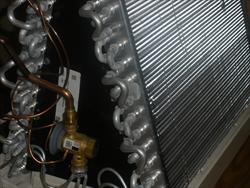Braze Joint Repair: Aluminum Heat Exchangers
Brazing aluminum heat exchangers is a challenging task. Why? Aluminum melts at a low temperature (~1100-1200°F/593-649°C) and does not change color as it heats, so you have almost no notice before the base material melts away. This means there is a tight window in which you must introduce the filler metal. The industry’s most common brazing alloy for aluminum brazing, Lucas-Milhaupt Al 718, melts at 1080°F/582°C, which is the melting point of some aluminum tubes.
This challenging nature of brazing aluminum parts can result in leaks. Many heat exchangers must be replaced under warranty due to leaks developed prematurely in service – a costly practice. Is there a better alternative?

Repairing Leaks
Lucas Milhaupt offers a brazing alloy that you can use to repair leaks and extend the heat exchanger’s life beyond the warranty period. We designed Al 822 specifically for this repair application. It has a wide melt range, which gives the alloy a sluggish flow so it can fill both small and wide voids. It also has a lower melting temperature of 900°F/482°C, which offers a larger margin of error during the brazing process than the traditional aluminum-brazing alloy. Test results have shown that joints brazed with Al 822 are just as strong as the higher-melting-temperature alloy when you use proper brazing techniques.
The Process
To repair a leak, clean the surface of the braze joint of all refrigerant and dirt. There are condenser coil cleaners you can purchase from your local distributor to remove these contaminants. Just before brazing, brush the surface using a wire brush to remove heavy oxides and old flux residue. Since Al 822 is a flux-cored product, no additional flux is necessary.
Heat the surface of the leak until it reaches the melting temperature of the Al 822 alloy. Occasionally tap the rod against the crack to gauge the temperature, because the aluminum heat exchanger will not change color to give notice. When you are ready to apply the brazing material, feed it face first into the joint to allow the flux to flow out before the alloy.
When the leak appears to be filled, immediately remove the heat and the brazing rod, because overheating would cause the crack to grow and become irreparable. Al 822 is cored with a noncorrosive flux, so there is no need to clean the surface after the repair. Using this technique, you can cost-effectively repair the heat exchanger and extend its service life.
CONCLUSION:
Brazing aluminum heat exchangers is a challenging task, making them susceptible to leaks during service. Replacing them under warranty is costly. Consider the alternative of repairing leaks with Lucas-Milhaupt brazing alloy Al 822, specially made for this application. Please contact the Lucas-Milhaupt Technical Services Department for further recommendations on the best brazing products for your needs.
Questions? We are pleased to provide expert information for Global Brazing Solutions® through our blogs and instructional videos. Feel free to share this posting with associates, and save our blog site to your Favorites.
Additional resources:
Aluminum HVAC Repair Video by Lucas-Milhaupt
Nu-Blast Condenser Coil Cleaner
Contact us for further assistance. For detailed questions, call Lucas-Milhaupt at 800.558.3856.
Disclaimer: Lucas-Milhaupt, Inc. believes the information contained herein to be reliable. However, Lucas-Milhaupt gives the technical information without charge, and the user shall use such information at its own discretion and risk.

